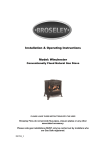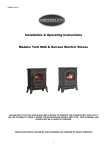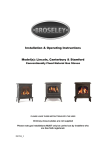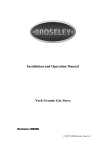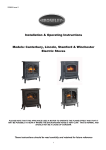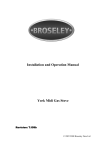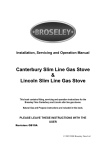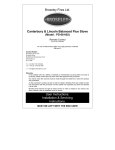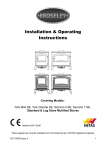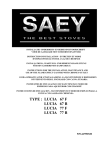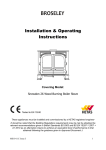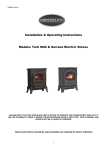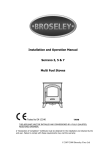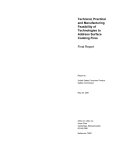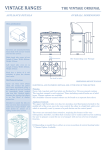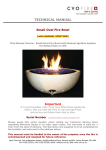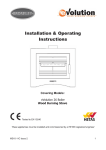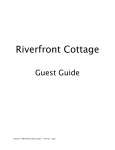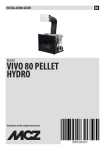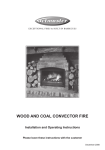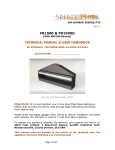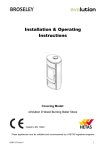Download Installation & Operating Instructions Model: York Midi
Transcript
Installation & Operating Instructions Model: York Midi Conventionally Flued Natural Gas Stove PLEASE LEAVE THESE INSTRUCTIONS WITH THE USER Broseley Fires do not provide flue pipes, closure plates or any other associated accessory. Please note gas installations MUST only be carried out by installers who are Gas Safe registered. 200708_3 Contents Introduction Packing List Specification Dimensions 3 3 4 4 Hearth Requirements Chimney Requirements 5 6 Assembly Burner Installation Gas Connection & Pressure Testing Positioning the Coal Ceramics 7 8 8 Spillage Testing 10 Operating the Stove The Remote Control 11 12 Curing the Paint & Warning Notes Trouble-shooting 15 16 Servicing Instructions Commissioning Form Annual Service Record Guarantee 17 28 19 20 200707_3 2 Introduction THANK YOU FOR PURCHASING A GAS FIRED STOVE Broseley Fires Ltd, a family run company, was founded as an appliance and design development company in 1975. Since then we have built up an enviable reputation for the quality, reliability and fuel efficiency of our stoves. These instructions have been carefully prepared to guide the installer and end-user through the relevant methods and standards for installation of your new Gas Stove. Correctly installed and operated, your stove will give you many years of warmth and reliability. Therefore, we would suggest that you read the whole instruction manual prior to handing it to your installer. That way you will have a clearer picture of what is involved. It is required by law that the complete assembly, installation and commissioning of gas-fired stoves is carried out by a professionally qualified and accredited gas fitter listed on the “Gas Safe” register. Please Note: • • • • • THE INSTALLATION MUST BE CARRIED OUT BY A GAS SAFE REGISTERED ENGINEER IN ACCORDANCE WITH THE ‘GAS SAFETY INSTALLATION AND USE REGULATIONS’ IN CONJUNCTION WITH THESE INSTRUCTIONS. THE RELEVANT ‘BRITISH STANDARDS CODES OF PRACTICE’ REQUIREMENTS AND THE RELEVANT ‘LOCAL AND NATIONAL BUILDING REGULATIONS’ MUST BE ADHERED TO. A COMMISSIONING CERTIFICATE MUST BE LEFT WITH THE END CUSTOMER UPON FINAL COMPLETION. THE COMMISSIONING FORM MUST BE COMPLETED IN THE BACK OF THESE INSTRUCTIONS PRIOR TO HANDOVER TO THE END CUSTOMER. THE PRODUCT MUST BE SERVICED ANNUALLY AND THE SERVICE RECORD COMPLETED IN THESE INSTRUCTIONS BY THE GAS SAFE ENGINEER. Packing List Stove Box 1 x Cast Iron Stove Body 1 x Box containing - 4 x Stove Legs, Allen key and Handle 4 x Sets of Nuts, Bolts and Washers, 1 x Flue Spigot Ceramic Box 1 x Base Coal Matrix 1 x Front Coal Matrix 1 x Rear Coal Matrix 5 x Small Loose Coals Burner Box 1 x Burner Unit 1 x Instruction Booklet (This document) 1 x Screw & Washer (To affix gas burner in place) 1 x Remote/ Receiver 200707_3 3 Specification Heat Input (Gross) Max Heat Ouput Gas Category Supply Pressure Gas Rate Injector Size Spigot diameter Weight Country of destination Efficiency 6.2 kW 4.6 kW I2H 20 mbar 0.59 m3/hr 420 125mm (5”) 65 Kg GB, IE Class 1 Please note this product is designed to only use natural gas. Dimensions All dimensions are in millimetres 200707_3 4 Hearth Requirements The appliance needs to be located onto a solid non-combustible hearth with a minimum thickness of 12mm. The hearth must be capable of withstanding the weight of the appliance. To ensure correct combustion the following minimum clearances must be adhered to: Inglenook Installation Stove Clearances Non-Combustible Combustible Freestanding Installation A 75mm N/A B 75mm 610mm C 50mm 610mm Above 100mm 610mm Please note these are minimum clearances, whenever possible it is advisable to have as much clearance as possible around the stove for easy access and maintenance. Please note the gas supply connection to the appliance is in the centre underneath the stove. The connection requires an 8mm-diameter semi-rigid pipe, not more than 1 meter in length. 200707_3 5 Chimney Requirements Please note Broseley Fires do not provide flue pipes, closure plates or any other associated accessory. The stove must be installed in accordance with current gas and buildings regulations BS5871: Part1. The appliance can be installed in any adequate area suitable for solid fuel fires and stoves. It can use a class 1, class 2 and pre-cast flue. For pre-cast flue installations it is ESSENTIAL that a sealed connection is made into the actual flue system (a void behind a closure plate is not permitted). Please refer to the codes of best practice for further advice on pre-cast flue’s. Before you install the stove, make sure the chimney flue outlet is correctly positioned to align with the flue outlet on the stove and that the chimney is in good condition. If not, a chimney liner must be installed or a suitable class II gas flue used. A draught is necessary to ensure the products of combustion are fully evacuated. Ideally it is recommended that the flue run is as straight as possible using the top outlet on the stove. When using the rear outlet (if alignment of the top outlet is not possible) a “T” shaped flue section should be used, the bottom of the “T” can be capped providing a catchment area for chimney dust/debris as well as providing a sweeping position. The flue must have a minimum vertical height of 3 metres to insure adequate draught. You can have a maximum of four bends in the run, each bend must not exceed 45° and an additional metre of vertical flue should be provided for each bend. We also recommend a minimum vertical section of 600mm before any bend immediately off the appliance. Prior to installation, the installer should insure that the flue is free from obstruction and any dampers must be fixed in a permanently open position. Ensure the chimney is not closed and that it has been swept and subsequently smoke tested. Make sure that rain, birds or any foreign body cannot get into the chimney to cause damage or blockage. This problem can normally be overcome by fitting an approved gas cowl. It is essential for the effective running of your stove that the chimney draws properly to allow the products of combustion to escape. VENTILATION (GB ONLY) The gas stove is rated at less than 7kw and therefore does not normally require additional ventilation in the room (BS5871 – part II). 200707_3 6 Assembly - Burner Installation Ensure all components are present prior to commencing assembly (See Packing List on page 3). 1. Unscrew the M6 x 18 Hex Bolt and open the main stove door to retrieve the box containing the 4 Legs, Handle and Allen Key. Using the bolts located in the bottom of the stove affix the Legs. 2. Next, with the stove stood upright insert the burner (control first) through the door. Dip the controls through the bottom of the stove so that the burner comes to rest on its side brackets (these prevent the burner from moving sideways). The controls should be on the right hand side of the stove. Fixing point for single self tapper Side Bracket Side Bracket 3. Fix the burner in place using the single self tapper to connect the burner to the rear panel of the stove (bracket located in the centre). 4. With the burner installed thread the wires running from the TTB device (mounted on the rear panel of the stove) through the hole in the rear of the stove and down to the 6.3mm Spade terminal connectors on the thermocouple interrupter (Located at the rear of the Valve assembly as shown below), These wires can be installed either way round on the terminals. 200707_3 7 Assembly – Gas Connection & Pressure Testing A minimum 15mm-diameter gas supply pipe must be used to within 1 metre of the installation with the final connection to the stove to be completed with the suitable 8mm semi-rigid gas pipe. The 8mm pipe should be connected to the inlet of the gas valve using the nut and 8mm olive provided. Support the control whilst finally tightening the supply pipe. A gas safety tap / restrictor elbow with a pressure test point at the inlet to the burner is provided. PRESSURE TESTING Always make sure that there is adequate gas pressure and volume to the stove. The relevant pressures are on the ID plate on the gas control knob. 1. For natural gas, this is 20mbar measured at the burner test nipple situated at the inlet connection to the stove with the appliance in the full rate position. 2. Ensure that the gas pressure to the stove is maintained when it is operating at the same time as other appliances in the building and that a suitable pressure gauge is used i.e. a manometer. Any service call as a result of incorrect gas pressure will be chargeable. Assembly – Positioning the Coal Ceramics Only the ceramics supplied with this appliance should be used. The ceramics should only be laid as described. Replacement ceramics are available from your dealer. Whilst arranging the ceramics, ensure that the pilot is not obstructed. Broseley Fires Ltd accepts no responsibility for any injury sustained whilst handling hot ceramics. Before any ceramics are placed in position ensure that the burner is operating correctly. The flames should be fairly even across the burners mesh top. Ceramics which are found to be placed other than in accordance with these instructions will result in a charge being made following any service callout. 200707_3 8 Assembly – Positioning the Coal Ceramics Warning: Ceramic coals are very fragile so always handle with care when fitting them. Follow these instructions carefully. Ceramics that are positioned wrongly could seriously alter the performance of your appliance. Stage 1 Place largest coal matrix firmly against the back of the stove with the three arches to the bottom and central above the burner mesh. Stage 3 Place the final coal matrix on top of the largest coal matrix and push firmly against the back of the stove. Ensure that it is central and the two largest coals in the matrix are facing forward. Stage 2 Place the smaller of the two remaining coal matrixes in front of the previous section with the pilot cut-out to the bottom. Then ease the two pieces forward so that they are a snug fit at the front. Stage 4 Place three loose coals above the three large coal mouldings on the largest matrix, these coals are to be located between the coal mouldings on the final coal matrix (shown in Stage 3). The other two loose coals are placed in the depressions in front of the three large coal mouldings of the large matrix (Shown in Stage 1) and the front matrix (Shown in Stage 2). Finally, close the stove door and wind on the M6 x 18 hex bolt back onto the door fixing bolt, slide the handle over the nut and using the Allen key supplied tighten the grub screw onto the nut. 200707_3 9 Spillage Testing A Spillage Test MUST be made before the installed fire is left with the customer. Carry out the test by first closing all doors and windows in the room containing the fire. Insure that the fire is burning at full rate for a minimum of 10-15 minutes. Using a lighted smoke match run it along the top edge of the draught diverter on the rear of the stove, observing the smoke being drawn into the dilution box, after 10 minutes repeat the test If there is an extractor fan in a nearby room the spillage test must be repeated with the fan running and all connecting doors between the fire and fan left open. If there are still problems, the chimney / flue may require attention. Disconnect the stove and seek expert advice. SPILLAGE MONITORING SYSTEM This appliance is fitted with a Temperature sensing cut out (TTB) device in the event of the flue being blocked the device will recognise the fault as an increase in heat inside the stove and shut the appliance down within a safe period so that there is no excessive build up of products of combustion inside the room. This operation would only occur if the flue path suffered severe blockage and /or ventilation was severely impeded. THE FOLLOWING ARE IMPORTANT WARNINGS RELATIVE TO THE SPILLAGE MONITORING SYSTEM 1. The installer must not attempt any adjustments to the spillage monitoring system. 2. There must be no attempt to disable the spillage monitoring system. 3. It is not possible to replace individual parts of the pilot assembly on the appliance – only a complete pilot assembly (including thermocouple) may be fitted in the event of a replacement being necessary. When the spillage monitoring system is replaced, only complete and original manufactures’ parts may be fitted. 4. Should the appliance turn itself off, wait for a minimum of 3 minutes before attempting to re-light. In the event of your stove tripping out, consult your installation engineer to have the flue / chimney checked. 200707_3 10 Operating the Stove It is important to read these instructions thoroughly before lighting the stove. The gas stove operates with a traditional permanent pilot light. The knobs for ignition and power control are located on the lower right hand side of the stove. The pilot light is located at the front middle of the coal matrix. If the Flame Supervision Device Actuating Flame (the pilot light) is extinguished by intention or not, no attempt should be made to re-light until 3 minutes have elapsed. IGNITING THE PERMANENT PILOT LIGHT 1. Depress the rear control knob fully. 2. Whilst depressed, turn knob sharply 90 degrees anti-clockwise to “pilot” setting. Repeat until pilot light is visibly lit. You should feel some resistance and hear a click. Repeat until the pilot lights. 3. Keep knob depressed at this point for 15-20 seconds. 4. Upon releasing, turn the knob anti-clockwise until it stops in the permanent pilot light position. The permanent pilot light will remain lit. This is the position for remote operation and can be left with the pilot running. You may wish to turn off the stove during long periods of non-use perhaps during the summer months. EXTINGUISHING THE STOVE FULLY 1. From any heat setting or the permanent pilot, depress the rear control knob and turn clockwise to “OFF” position. Should the glass door become broken or damaged in any way, turn your stove off and do not attempt to re-light it. Contact your dealer for a replacement to be fitted before relighting the appliance. PLEASE EXPLAIN TO THE CUSTOMER THESE LIGHTING AND EXTINGUSIHING PROCEDURES AND THAT IT IS NORMAL FOR THE STOVE TO GIVE OFF ODOURS WHILST THE PAINT, SEALANT AND CAST IRON MATURES. 200707_3 11 Operating the Stove – The Remote Control POSITIONING THE RECEIVER After fitting the batteries in the receiver and the hand set, place the receiver anywhere on the hearth. There is a long lead on the receiver to allow you to position the receiver towards the front of the hearth, if you wish to see the light come on when the handset is in use. Place the lead on the hearth also. Failure to do this will cause malfunction of the unit. OPERATING INSTRUCTIONS FOR G30-ZRPTT REMOTE CONTROL Caution! Read these instructions entirely before use. G30-ZRPTT remote controls must be installed and operated according to all locally applicable regulations! G30-ZRPTT Remote Controls are designed for use only in gas fires equipped with specially designed combination controls (GV34 or GV36 retrofitted with a motor) produced by Mertik Maxitrol. Due to the integrated thermostat, the G30-ZRPTT is not to be used with open gas fires! Technical Data Ultrasound Transmission Ambient Temperature Batteries Range: 1...10m 3...33ft. Frequency: ON 40,5kHz, OFF 40kHz Transmitter & Receiver max. 60°C 140°F Connecting Cables: max. 180°C 356°F Handset: 1 x 9V block (alkaline recommended) Receiver: 4 x 1,5V AA (alkaline recommended) Connections The G30-ZRPTT is intended for use only with motorized gas combination controls models GV34 (or GV36 retrofitted with a motor). The receiver cable must be firmly plugged onto the flat blade connectors (motor: 6.3 and 4.8mm micro switch both 2,8mm see illustration 2). A 200707_3 12 B Operating the Stove – The Remote Control Transmitter Function Set the Display After connecting the battery or by simultaneously pressing AUTO and TIMER, the display flashes. You are in set mode. From set mode, press AUTO to switch from °F (and 12 hour clock) to °C (and 24 hour clock) or vice versa. The display will automatically return to manual mode after some time, but you may immediately return to manual by depressing the TIMER button. Set the current Time After connecting the battery or by simultaneously pressing AUTO and TIMER, the display flashes. You are in set mode. From set mode, press (p) to set the hour and (q) to set the minute. Wait or press TIMER to return to “manual“ mode. Programming the Desired Set Temperature Press AUTO until the display flashes. Press (p) or (q) to set the desired temperature. Wait or press AUTO to switch to automatic mode. A sensor in the transmitter measures the room temperature. The controller compares the room temperature with the set temperature and sends a signal to the receiver to turn the gas valve motor, which adjusts the flame height accordingly. Programming the Timer Press TIMER until P1* flashes (period 1, heating cycle on). Set the time for the beginning of the first heating period by pressing (p) for hour and (q) for minute. Press TIMER again; P1w appears. Set the time for the end of the first heating period. Press TIMER again to set the second heating period P2* (heat on) and P2w (heat off). Store both heating periods by pressing TIMER again. • If only one heating period is desired, program the same time for P2* nd P2w. Manual Mode (MAN in display) for Manual Flame Height Adjustment press (p) to turn on the fire (main burner) or to increase flame height. Press (q) to decrease flame or to turn down to pilot. To incrementally increase or decrease the flame height lightly tap either the (p) or (q) button. The “send“ symbol appears in the upper left corner of the display when either button is depressed. The LED of the receiver flashes when knob B of the valve reaches its end stops. Automatic Mode (AUTO in display) for Temperature Control Briefly press AUTO. The set temperature will appear briefly before the display reverts to the room temperature. 200707_3 13 Operating the Stove – The Remote Control Timer Mode (TIMER in display) • During heating periods P1* and P2*, the temperature is controlled in the same manner as in automatic mode. When the timer program turns to w (heating cycle off), the motor will turn the valve to pilot and there is no temperature control. This minimizes battery consumption. You may press AUTO to verify the set-temperature and then press TIMER to return to timer mode. You may press either the (p) or (q) button from any mode for manual override. To prolong battery life, we recommend switching the transmitter to manual mode and turning the fire to pilot with the (q) button before turning the appliance off. If the transmitter is left in automatic or timer mode, the batteries will continue to be used when the appliance is off. Changing the Battery If BATT appears in upper right hand corner of the display or if the LED of the receiver becomes faint, please change the battery from transmitter or receiver. If the batteries lose power, the flame height can be adjusted by manually turning knob B (see illustration 2). Note Please note, the placement of the transmitter (temperature sensor) is important to assure proper temperature regulation. Generally, a more contstant temperature will be assured, if the transmitter is not too far from the gas appliance. Before switching to AUTO or TIMER mode, press either button (p) or (q) to verify the reception (when the send symbol appears in the transmitter display, the receiver’s LED must illuminate). For the AUTO or TIMER mode to function correctly, the transmitter must remain within range of the receiver. The transmitter should not be used in very close proximity to the receiver (less than 1m / 3ft) as this could, in very rare cases, produce a electronic switching error. This error could block the motor when the knob reaches the end points of its turning radius. The knob must then be turned manually to free the blockage. The temperature is controlled by activating the motor for a specific length of time to adjust the appropriate flame height. This time is calculated by the transmitter and depends on variables such as room size, heater capacity, battery power, etc. Therefore, a few cycles are necessary before an optimum is achieved. If a low flame is sufficient to provide enough warmth to the room, then the appliance will cycle between low fire and off. This allows longer periods with the flame on and provides a more uniform room temperature. NOTE TO THE INSTALLATION ENGINEER Please make sure the customer is familiar with the initial lighting and operating procedures before leaving the site and that this instruction booklet is left with them when the final commissioning is complete. 200707_3 14 Curing the Paint It is important to note that upon initial lighting of the stove you will notice a strong odour, this is the paint curing and is completely normal. Most high temperature paints operate in the same way. They use a resin which dries at room temperature and a silicon resin which cures at high temperatures. When the stove is burned the dry resin burns away and the silicon cures. This transition occurs at about 475°F. Curing times will vary for each stove, we recommend leaving the fire on high for an extended period. The house needs to be fully ventilated during these initial burnings and although the smoke is mostly Carbon Dioxide there are other components of the smoke which make it smell bad and may irritate some people. These problems will go away after the paint is fully cured. Please note switching off the appliance when you first notice the smell will simply prolong the curing process, as recommended above the fire needs to be left on in the high setting. Warning Notes We would remind you that it is a legal requirement that the stove is installed by a qualified and accredited GAS SAFE installation engineer. Improper installation, adjustment, alteration, service or maintenance can cause personal injury and / or damage to property. If you are in the slightest doubt about any aspect of your stove’s performance or you require additional information then please contact your stove supplier, a qualified installation engineer or call our technical help-line on 01743 461444. Please do not store, keep or use petrol or any other flammable liquids, vapours or substances anywhere near the stove or any other heating appliance. We hope these instructions are clear and helpful and you are able to enjoy the full benefits of your stove. Please keep this booklet handy for future reference. The materials used in building your gas stove are guaranteed for one year provided the assembly and operation complies with these instructions. Accidental damage and all consumables including the glass door seal are not covered. We are sure you will appreciate and accept that our guarantee cannot be extended to cover the assembly, installation and the use of your stove as these are all operations outside our control or influence. Please retain your purchase receipt. We will need to see this in the event of a claim under warranty. 200707_3 15 Trouble-shooting THE GAS PILOT WILL NOT IGNITE OR STAY LIT • • • • • • • • • Ensure the gas is turned on at the appliance and the meter / cylinder. Hold the pilot gas button for at lest 20 seconds once the pilot is alight to ensure the operation of the safety thermocouple valve. Ensure that the pilot injector is not obstructed or blocked and it is free from any dust or dirt. Ensure that the thermocouple has not been damaged in transit. This is a very delicate device. On bottled gas (LPG), check that the cylinder is not empty. Ensure that the aeration ring shutter on the pilot head is fully open so that the pilot flame is initially intense: this can be subsequently turned down. Ensure the pilot flame is the correct size for the type of gas. The flame should be focused on the thermocouple probe, so that it is evenly encircled. Any whistling sound you hear is normally caused by dirt obstructing the pilot. This is normally cured by carrying out the cleaning process outlined in the next section entitled Servicing Instructions. After altering the pilot, check for any leakage of gas THE MAIN BURNER DOES NOT SEEM TO BURN CORRECTLTY • • • Ensure there is adequate gas pressure to the appliance. The pressure can be obtained by unscrewing the pressure test nipple and applying a suitable pressure gauge (i.e. A MANOMETER). Be sure that the gas pressure agrees with the identification label on your stove. Ensure adequate volume of gas is being used. Once the fire is burning on maximum, turn off all other gas appliances in the house and calculate the fuel being burned from the gas meter. See that the burner is burning evenly across the whole of the mesh surface without any coals in place. THE MAIN BURNER WILL NOT IGNITE OR STAY LIT • Ensure that the connections from the TTB to the rear of the valve assembly are connected. If these are not connected then the burner will not light. 200707_3 16 Servicing Instructions Servicing should be carried out annually by a qualified installation engineer when the stove is cold and the gas supply is turned off at the isolation tap. The following points should be checked. • • • • • • Remove the coals and clean any dust and debris from the top of the burner unit. Ideally a vacuum cleaner should be used, but a soft brush will do. Check the condition of the coals. Any damaged ones will affect the efficient operation of the stove and should be replaced with new ones available from your stove supplier. All gas supply joints should be checked to make sure they are completely sealed and that the gas supply and pressure is to specification. The pilot jets are correctly set and clear of obstruction. The chimney should also be checked to make sure there are no restrictions or blockages. Finally re-lay the coals and re-light the stove as described previously. 200707_3 17 Commissioning Form THIS SECTION MUST BE COMPLETED AND SIGNED BY THE INSTALLATION ENGINEER PLEASE LEAVE WITH THE CUSTOMER AND THE APPLIANCE. Size of Governor setting: (i.e.) Natural Gas 20MBAR Length and size of gas supply: _______________ Meter pressure Fire only on: ________________ All Other appliances on: __________________ Burner pressure Fire only on: _______________ All Other appliances on: __________________ Gas rate - Natural Gas - Time for 1 cubic foot in seconds: ___________ Overall length of flue: __________ Is there any spillage: __________Is the draught excessive: __________ Is there any permanent ventilation in the room: ____________________ Has the room double glazing: ______________ Is the aeration of the pilot correct: __________ Does the flame encircle the FFD: ___________ Installation Engineers Name: _____________________________________________________ Address __________________________________ __________________________________ __________________________________ __________________________________ Post Code: ______________________________________ Telephone: __________________ Fax:__________________Mobile:______________________ Gas Safe Registration No: _______________________________________________________ Signed: ___________________________________ Date: _________________ 1st service is due a year from this date 200707_3 18 Annual Service Record 1ST YEAR SERVICE completion date: SERVICE ENGINEER: COMPANY NAME: COMPANY ADDRESS: REG. No. . . POSTCODE: CONTACT NUMBER 2ND YEAR SERVICE completion date: SERVICE ENGINEER: COMPANY NAME: COMPANY ADDRESS: .. . REG. No. . POSTCODE: 3RD YEAR SERVICE completion date: SERVICE ENGINEER: COMPANY NAME: COMPANY ADDRESS: REG. No. . . POSTCODE: 4TH YEAR SERVICE completion date: SERVICE ENGINEER: COMPANY NAME: COMPANY ADDRESS: REG. No. . . POSTCODE: 5TH YEAR SERVICE completion date: SERVICE ENGINEER: COMPANY NAME: COMPANY ADDRESS: REG. No. . . POSTCODE: 6TH YEAR SERVICE completion date: SERVICE ENGINEER: COMPANY NAME: COMPANY ADDRESS: REG. No. POSTCODE: Receipts should be retained for each year’s service beyond year 6 200707_3 19 Guarantee Your decorative gas fire, when installed in accordance with the installation instructions and operated in accordance with these instructions should provide many years of safe and efficient operation. We thank you for purchasing our product and trust it will provide excellent service. This appliance carries a guarantee of One (1) Year. We agree to repair free of charge or, at our option, replace the appliance or part thereof, which may prove to be defective within the guarantee period. The guarantee is void if: • • • • • • The appliance is not installed and operated in accordance with our instructions, or Repairs or modifications have been carried out by the purchaser or any third party not authorised by us or: The appliance has been misused or accidentally damaged, or Damage is due to ‘fair wear and tear.’ or The appliance or defective component(s) are not returned to us, prepaid postage. The appliance has not been serviced annually by a ‘Gas Safe Registered’ engineer. The rights given in this guarantee are limited to the UK mainland and are in addition to any to which you may have a statutory entitlement. Please retain your purchase receipt. We will need to see this in the event of a claim under warranty. Broseley Fires Ltd Knights Way Battlefield Enterprise Park Shrewsbury Shropshire SY1 3AB Tel: 01743 461444 Fax: 01743 461446 http://www.broseleyfires.com 200707_3 20




















